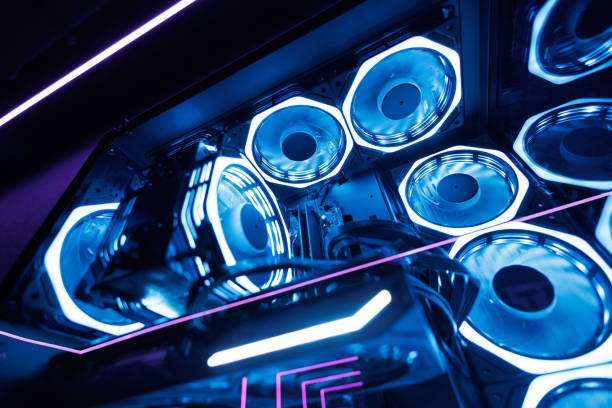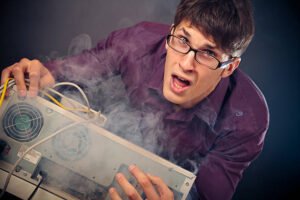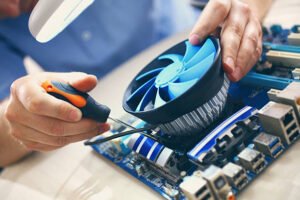Case Fans Not Spinning
There is one specific difficulty that directs your focus wrong during PC construction or fault detection—case fans not spinning. If fans operate improperly, they can lead to small issues, but their improper operation can create major system problems, including temperature increases and dropped performance levels, as well as device physical damage if they are not addressed quickly. The guide provides assistance to both beginners and users who struggle to understand noise issues with their construction.

The purpose of this guide is to explain possible causes of your unspinning case fans while showing you a method to investigate without creating additional disruptions.
Why Are Case Fans Important?
Before exploring specific problems, it becomes essential to establish the fundamental importance of case fans not spinning overall. All computer systems require case fans as essential elements to deliver essential liquid coolant to their internal working parts. The device pulls cool air into its case’s direction to release hot air out, which builds effective airflow to cool down the CPU, GPU, and other components.
The failure of fans to operate correctly results in your computer transforming into a drastic heat source that threatens various sensitive hardware elements. Hardware damage and thermal throttling, along with crashes, are long-term results that can derive from this situation. React immediately whenever you observe your case fans not spinning because these problems demand urgent care.
Common Reasons for Case Fans Not Spinning
This report explains the primary factors that cause the above-described case fans not spinning issue.
1. Disconnected or Loose Fan Cables
Building a personal computer entails a risk of cable omission, especially during the assembly process or during the addition of new components. You should check that fan cables lead directly from their source to motherboard ports or to a fan hub when it is present.
The solution involves disconnecting the case while paying close attention to each fan wire before checking that the wires connect to SYS_FAN or CHA_FAN motherboard pins or Molex or SATA connectors directly from the power supply.
2. BIOS Settings Misconfigured
The fans can receive power from the system but remain still because of incorrect BIOS configurations. The fan will fail to turn at all when the turn is set at a low level, even when the system exceeds its temperature threshold.
Navigate to BIOS by pressing DEL or F2 at the computer startup, then find the fan control section. Users can modify the fan curves to full-speed operation in this section, thus ensuring fan functionality.
3. Fan Curve or Software Control Issues
The noise level is directly affected by these programs, such as ASUS AI Suite or MSI Dragon Center, which exist in modern systems to manage fan speeds. The failure of these tools would leave you case fans not spinning at exactly the moment you need them.
Check fan operation using software disable mode followed by default BIOS testing. You should start by removing the control software and then reinstalling it fresh if needed because the software appears to be problematic.
4. Dead or Faulty Fan
The single issue could stem from a malfunctioning fan that requires replacement. The operation of fans can be interrupted by dust accumulation and manufacturing defects or random causes, eventually leading to total fan failure.
Fans should be plugged into an alternative power source or connector to determine if the port is responsible for the issue. The solution needs replacement of the device when the previous steps fail to address the issue.
5. Insufficient Power Supply
Power supply discrepancies sometimes cause this issue, so your case fans not spinning is signaling such a problem. The fans operate at a slower speed when you use a PSU with insufficient power or when the power cable connections are not correct.
Verify that all power cables receive proper socket connections. A high-power computer system with multiple GPUs and drives requires an upgraded PSU for proper functionality.
How to Troubleshoot When Case Fans Are Not Spinning
The following is a basic sequence for identifying spinning case fan issues with proper and improper actions:
The process to totally eliminate viruses requires shutting down the PC and unplugging it from the power source.
Open the side of the left case panel carefully to access the case interior.
Verify that all fans have proper connections, which ensure a secure connection.
Before testing the motherboard header issue, you need to directly attach the LED to the power supply.
The final task involves checking BIOS configuration, while those making fan curve adjustments should proceed.
You should evaluate fan performance by plugging it into either another system or another available fan header.
Users should examine the fan blades because blocked debris and dust could obstruct the fan operation.
One blink from the fan during startup indicates a fan failure. The weak brightness of the blink signals the malfunction.
This organized sequence helps you identify whether the problem lies in hardware or occurs within software and physical systems or involves faulty hardware components.
When Should You Worry?
Users may discover their case fans are not operating while using their PC, which should cause immediate concern. The system operates abnormally hot, or other components come online to compensate when these events occur.
The fans of your computer system remained quiet after being operational during initial setup and before the silence began. This could indicate loose connections as one possible cause. The article mentions a best solution to investigate these circumstances because such situations can produce devastating outcomes.
Future occurrences of these events need proper intervention along with prevention methods. The proper management of football activities represents the best method to streamline the game, which emphasizes the importance of resolving fan problems to stop their recurrence.
Proper management practices combined with construction methods will serve as the foundation for blocking Case Fans Not Spinning from establishing in the future. Here’s how:
The accumulation of dust affects fans frequently, which should be prevented completely.
People should invest in high-quality fan products available at market stores to minimize equipment breakdowns.
The tools CoolWizard or HWMonitor, together with SpeedFan, monitor system temperature continuously to ensure proper fan maintenance.
Staying within safe overclocking parameters represents the proper method for achieving overclocking goals because it reduces fan workload.
A proper labeling system helps identify cables throughout construction so maintenance personnel can easily find them during checks and upgrades.
The continued best performance of these fans depends on your practice of these habits.
Conclusion
If a person cannot find their case fans not spinning, it becomes a common, frustrating condition but still maintains solution potential. The problem resolution process remains clear even though it becomes uncertain if the BIOS requires adjustment or if the graphics card fan needs replacement. System PC well-being depends on adequate cooling, which will deteriorate if fans are abandoned.

Your immediate action prevents damage to your equipment, which means your devices will serve you longer. Paying attention to the total absence of noise signals may be even more concerning than typical mechanical sounds. Therefore, do not ignore absolute silence.
FAQs
My computer runs with the fans disabled, although the PC should be making sound. How to resolve?
Various factors, which include low fan curves together with BIOS settings and a nonfunctional fan, can lead to this issue. Check that your fan has a proper power connection, then attempt to adjust the fan curve start temperature to a level below your previous setting.
The case fans may fail to operate because of a malfunctioning motherboard. Is it?
There exists evidence that the fan headers on the motherboard suffer from defects that prevent power delivery to connected fans. To determine the source of the issue, one should connect the fan to another power connector or header for testing purposes.








